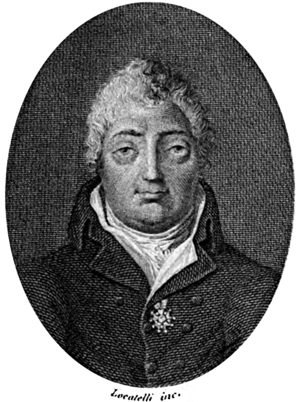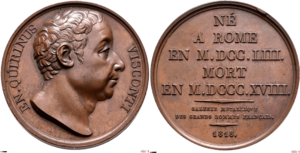Ennio Quirino Visconti facts for kids
Quick facts for kids
Ennio Quirino Visconti
|
|
|---|---|
 |
|
| Consul of the Roman Republic | |
| In office 20 March 1798 – 30 September 1799 Serving with Liborio Angelucci, Giacomo de Mattheis
|
|
| Preceded by | Office established |
| Succeeded by | Office abolished |
| Personal details | |
| Born | 1 November 1751 Rome, Papal States |
| Died | 7 February 1818 (aged 66) Paris, France |
| Profession | Politician, antiquarian, art historian |
Ennio Quirino Visconti (born November 1, 1751, died February 7, 1818) was an important person from Rome. He was a politician, but he was also an expert in old things (an antiquarian) and art history. He was known as the best expert on ancient Roman sculptures during his time.
His son, Pietro Ercole Visconti, helped publish some of his writings. Another son, Louis Visconti, became a famous architect in France. Ennio's brother, Filippo Aurelio Visconti, was also a scholar of ancient times.
Contents
His Life and Work
Ennio Quirino Visconti was born in Rome. His father, Giovanni Battista Antonio Visconti, was in charge of the Pope's collection of old artifacts. This collection was later organized into the Museo Pio-Clementino.
Becoming an Expert
Pope Pius VI chose Ennio to take over his father's job. In 1787, the very talented Visconti became a conservator at the Capitoline Museums in Rome. This meant he helped care for and restore ancient artworks.
He helped his father create the first book about the Museo Pio-Clementino. Then, he wrote six more books himself, finishing the last one in 1807. These books were a detailed list of all the Roman sculptures and old items in the Vatican. They had a huge impact on how people studied ancient history.
Visconti also wrote about other collections of old items. He described the items collected in Greece by Sir Richard Worsley in Museum Worsleyanum (1794). He also wrote about the sculptures at the Villa Borghese (1796).
Life in Politics and Paris
In 1798, Visconti became one of the five leaders, called consuls, of the short-lived Roman Republic. When the Pope regained control of Rome, Visconti had to leave. He moved to Paris, where he was welcomed.
In 1799, he became the curator of ancient artifacts at the Musée Napoleon, which is now the Louvre museum. Many of the items there were things taken from Rome under the Treaty of Tolentino (1797). Visconti knew these items well and wrote descriptions of them.
In 1803, he became a professor of archaeology at the Institut de France. In Paris, he published books with portraits of famous people from ancient times. These included Iconographie Grecque (3 volumes, 1808) and the first volume of Iconographie Romaine (1818).
When he passed away, many people wrote about his importance.
His Important Ideas About Art
Visconti was one of the experts asked to share their thoughts on the Elgin Marbles. These were ancient Greek sculptures that people wanted to bring to the United Kingdom. His ideas about their cultural value were very important.
Visconti was very good at identifying and understanding ancient art. He focused on figuring out who was shown in sculptures and reliefs. He also helped start modern art history. For example, he admitted that he might have thought a statue was more beautiful because he recognized the person it showed, like Phocion.
He felt a strong connection to the sculptures he grew up with. He believed that copies of famous Greek and Hellenistic statues, like the Apollo Belvedere and Laocoön and His Sons, were "perfected imitations." He thought that ancient sculpture improved over time, much like how people felt Virgil improved upon Homer.
After his death in 1818, a special medal was made in his honor. This medal was part of a series celebrating important French people. It showed how famous he was at that time.
What He Wrote
- Museo Pio-Clementino (Milano, 1820)
- Sculture del Palazzo della Villa Borghese della Pinciana brevemente desritte (2 volumes, 1796)
- Monumenti Scelti Borghesiani
- Monumenti Gabini
- Iconographia greca (published as Iconographie grècque, Paris 1808)
- First volume of Iconographie romaine (4 volumes, 1817–26), finished by Antoine Mongez
These five works were re-released later, with some changes, in Milan between 1827 and 1837. Some were published under the title Opere varie italiane e francesi, edited by Giovanni Labus.


